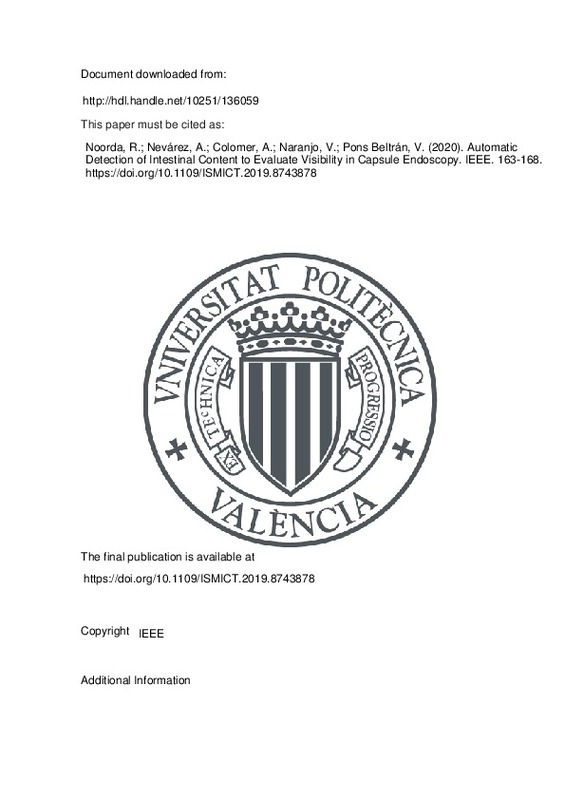JavaScript is disabled for your browser. Some features of this site may not work without it.
Buscar en RiuNet
Listar
Mi cuenta
Estadísticas
Ayuda RiuNet
Admin. UPV
Automatic Detection of Intestinal Content to Evaluate Visibility in Capsule Endoscopy
Mostrar el registro sencillo del ítem
Ficheros en el ítem
| dc.contributor.author | Noorda, Reinier
|
es_ES |
| dc.contributor.author | Nevárez, Andrea
|
es_ES |
| dc.contributor.author | Colomer, Adrián
|
es_ES |
| dc.contributor.author | Naranjo, Valery
|
es_ES |
| dc.contributor.author | Pons Beltrán, Vicente
|
es_ES |
| dc.date.accessioned | 2020-01-30T09:00:27Z | |
| dc.date.available | 2020-01-30T09:00:27Z | |
| dc.date.issued | 2020-01-30T09:00:27Z | |
| dc.identifier.isbn | 978-1-7281-2342-4 | |
| dc.identifier.issn | 2326-8301 | |
| dc.identifier.uri | http://hdl.handle.net/10251/136059 | |
| dc.description.abstract | In capsule endoscopy (CE), preparation of the small bowel before the procedure is believed to increase visibility of the mucosa for analysis. However, there is no consensus on the best method of preparation, while comparison is difficult due to the absence of an objective automated evaluation method. The method presented here aims to fill this gap by automatically detecting regions in frames of CE videos where the mucosa is covered by bile, bubbles and remainders of food. We implemented two different machine learning techniques for supervised classification of patches: one based on hand-crafted feature extraction and Support Vector Machine classification and the other based on fine-tuning different convolutional neural network (CNN) architectures, concretely VGG-16 and VGG-19. Using a data set of approximately 40,000 image patches obtained from 35 different patients, our best model achieved an average detection accuracy of 95.15% on our test patches, which is similar to significantly more complex detection methods used for similar purposes. We then estimate the probabilities at a pixel level by interpolating the patch probabilities and extract statistics from these, both on per-frame and per-video basis, intended for comparison of different videos. | es_ES |
| dc.description.sponsorship | This work was funded by the European Union’s H2020: MSCA: ITN program for the “Wireless In-body Environment Communication – WiBEC” project under the grant agreement no. 675353. | es_ES |
| dc.format.extent | 6 | es_ES |
| dc.language | Inglés | es_ES |
| dc.publisher | IEEE | es_ES |
| dc.rights | Reserva de todos los derechos | es_ES |
| dc.subject | Image processing | es_ES |
| dc.subject | Machine learning | es_ES |
| dc.subject | Support vector machines | es_ES |
| dc.subject | Local binary patterns | es_ES |
| dc.subject | Capsule endoscopy | es_ES |
| dc.subject | Small bowel preparation | es_ES |
| dc.subject | Convolutional neural networks | es_ES |
| dc.title | Automatic Detection of Intestinal Content to Evaluate Visibility in Capsule Endoscopy | es_ES |
| dc.type | Capítulo de libro | es_ES |
| dc.type | Comunicación en congreso | es_ES |
| dc.identifier.doi | 10.1109/ISMICT.2019.8743878 | |
| dc.relation.projectID | info:eu-repo/grantAgreement/EC/H2020/675353/EU/Wireless In-Body Environment/ | es_ES |
| dc.rights.accessRights | Abierto | es_ES |
| dc.contributor.affiliation | Universitat Politècnica de València. Instituto Universitario de Telecomunicación y Aplicaciones Multimedia - Institut Universitari de Telecomunicacions i Aplicacions Multimèdia | es_ES |
| dc.description.bibliographicCitation | Noorda, R.; Nevárez, A.; Colomer, A.; Naranjo, V.; Pons Beltrán, V. (2020). Automatic Detection of Intestinal Content to Evaluate Visibility in Capsule Endoscopy. IEEE. 163-168. https://doi.org/10.1109/ISMICT.2019.8743878 | es_ES |
| dc.description.accrualMethod | S | es_ES |
| dc.relation.conferencename | International Symposium on Medical Information and Communication Technology (ISMICT) | es_ES |
| dc.relation.conferencedate | Mayo 08-10,2019 | es_ES |
| dc.relation.conferenceplace | Oslo, Norway | es_ES |
| dc.relation.publisherversion | https://doi.org/10.1109/ISMICT.2019.8743878 | es_ES |
| dc.description.upvformatpinicio | 163 | es_ES |
| dc.description.upvformatpfin | 168 | es_ES |
| dc.type.version | info:eu-repo/semantics/publishedVersion | es_ES |
| dc.relation.pasarela | S\393105 | es_ES |
| dc.contributor.funder | European Commission | es_ES |







![[Cerrado]](/themes/UPV/images/candado.png)

